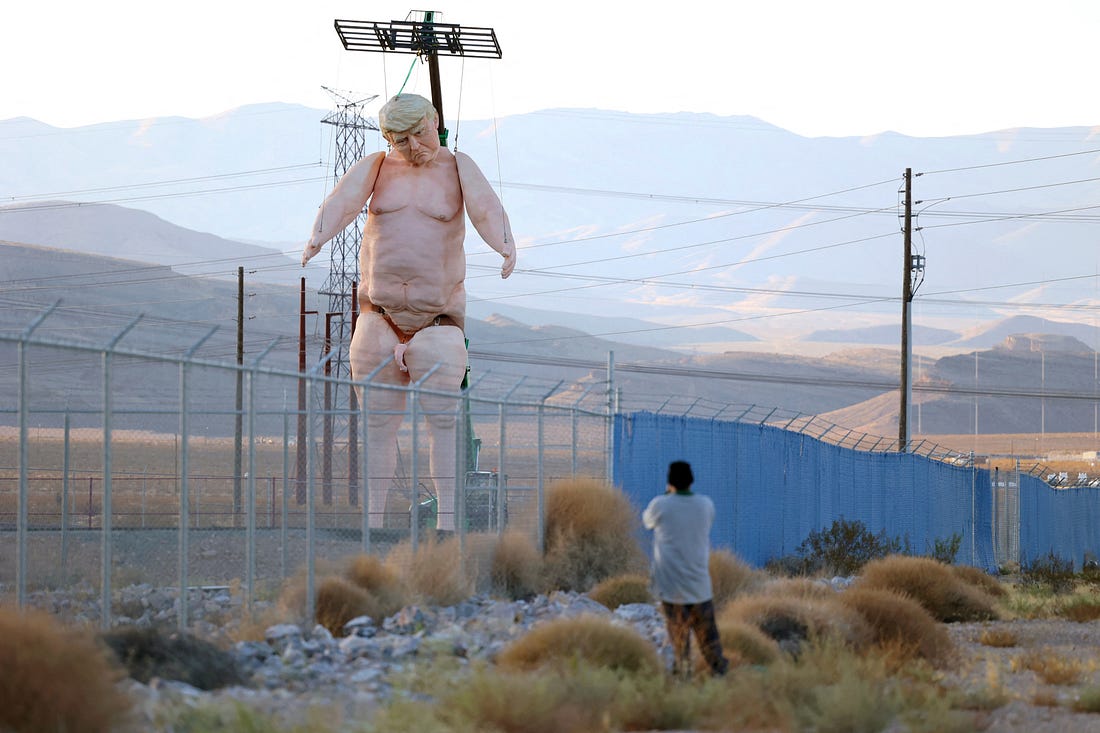|
 |
Hey, guys –
Bulwark art director Hannah Yoest here, sitting in for JVL, with some thoughts on art, politics, and our moment. Thanks for reading, and if you’d like to let us know what you think down in the comments, consider signing up for Bulwark+:
–Hannah
Trump, Fascism, and What Artists Can Do
There is tension between wanting art to transcend and wanting it to reflect reality back to us. Plus: Are Dems finally ready to retire the purity tests?
1. Degenerates, Deplorables, and Teflon Don
WHEN DONALD TRUMP WAS PRESIDENT the first time, the artistic world mocked, castigated, and condemned him. There were examples in a variety of media: illustrated tabloids, open letters, billboards, posters, performance art, you name it.
Why has the second Trump administration not, at least so far, faced the same level of artistic resistance as the first? There are a lot of theories! Exhaustion and a sense of futility top the list. In 2016, the impotence of art to influence politics troubled artists and critics. “One illusion that will be particularly painful to part with is the idea that high culture and the arts have any effective power in American life,” Adam Kirsch wrote ahead of Trump’s first inauguration.
And even before the 2016 election, a Guardian headline asked, “Where is Trump’s artistic mauling?” It wasn’t so much a question as a charge. Jonathan Jones proposed ideas for leading working artists, “The sheer strangeness of Trump practically makes him a living work of art. . . . There’s so much material.” Jones concludes, though, that the issue isn’t unique to Trumpian politics: “There is just one problem with Warhol’s mockery of Nixon and Heartfield’s visceral images of Hitler. Neither made much impact.”
Nevertheless, artists continued to work in protest throughout the first term. Some did so with nuance, at a remove, subtly using visual media to engage critically with the constant stream of chaos generated by the administration. Others just went for it, subtext be damned, erecting naked statues of Trump and posing with masks made to look like his severed head. Yet neither the high road or the low road led to anything. “Resistance” art came across as little more than political protest and communal grieving, if we’re being generous.
The feeling of irrelevance continued to stymie art produced during Biden’s tenure. In an essay titled “Can we please have less political art now?” published just days after Trump’s re-election, Kat Rosenfield makes the argument that the anti-Trump art movement was a blight: “The most memorable thing about the art shaped by this paradigm is how forgettable it all is, how small and predictable and shrill and soulless.”
We may want art to be the vector of change, but what it does best is reflect the culture of its time.
“The works that followed Trump’s exit from the White House were . . . a relentless, ruthless, humorless box-checking exercise in ideological piety,” Rosenfield writes. “Satire and other more sophisticated forms of storytelling were subsumed by an intense literal-mindedness, in keeping with a growing conviction that audiences were both dangerously malleable and much too stupid to grasp anything but the most ham-handed moral messaging.”
As JVL says, read the whole thing.
Part of the problem may be that the creative class faces higher expectations, or even puts higher expectations on themselves, to provide accountability in the form of artistic catharsis where the rule of law, public morality, and democratic accountability have all failed.
During the first Trump administration, the stakes were lower than they are now. Trump didn’t know what he was doing, and Congress was still pretending to make an effort to hold him accountable. (Remember when, for one shining moment, we thought Will Hurd might vote for Trump’s first impeachment?)
Maybe the standards we have for art are too high. We have a myth of twentieth-century art helping to save the world from tyranny. But art did as much to aid totalitarianism as it did to fight it. For every Doctor Zhivago, there was a Red Star; for every Jackson Pollock, there was a Ludwig Dettman; for every Stephen Spender and Encounter, there was a Novy Mir loaded with Communist functionary editors. And for what it’s worth, Doctor Zhivago, Jackson Pollock, and Encounter were all supported by the CIA.
Art didn’t win World War II or the Cold War. America did. And now America—at least, its government—is on the side of the baddies. It’s not even clear that the money and time and effort the CIA spent on artistic endeavors helped to weaken the Soviet Union in the slightest—yet more evidence that art as propaganda doesn’t work.
We didn’t see an artistic “mauling” of Trump during the first term in part because such a mauling is impossible given the total saturation of Trump’s image and his unparalleled memetic abilities to transfigure any and all media in service of his propaganda. We won’t see a mauling now in the second term due to the atmosphere of fear and constricting of America’s self-identity.
Do America and the world really need more grotesque creative interpretations of Trump and his visage?
The best art can do now is to activate in us the emotional and social muscles we’ve let atrophy in our public life: sympathy, humility, earnestness, horror. Guernica and the AIDS Memorial Quilts didn’t change minds but hearts.
2. The F-word
Fascism! It’s Trump’s whole deal, and it comes out in his rela
